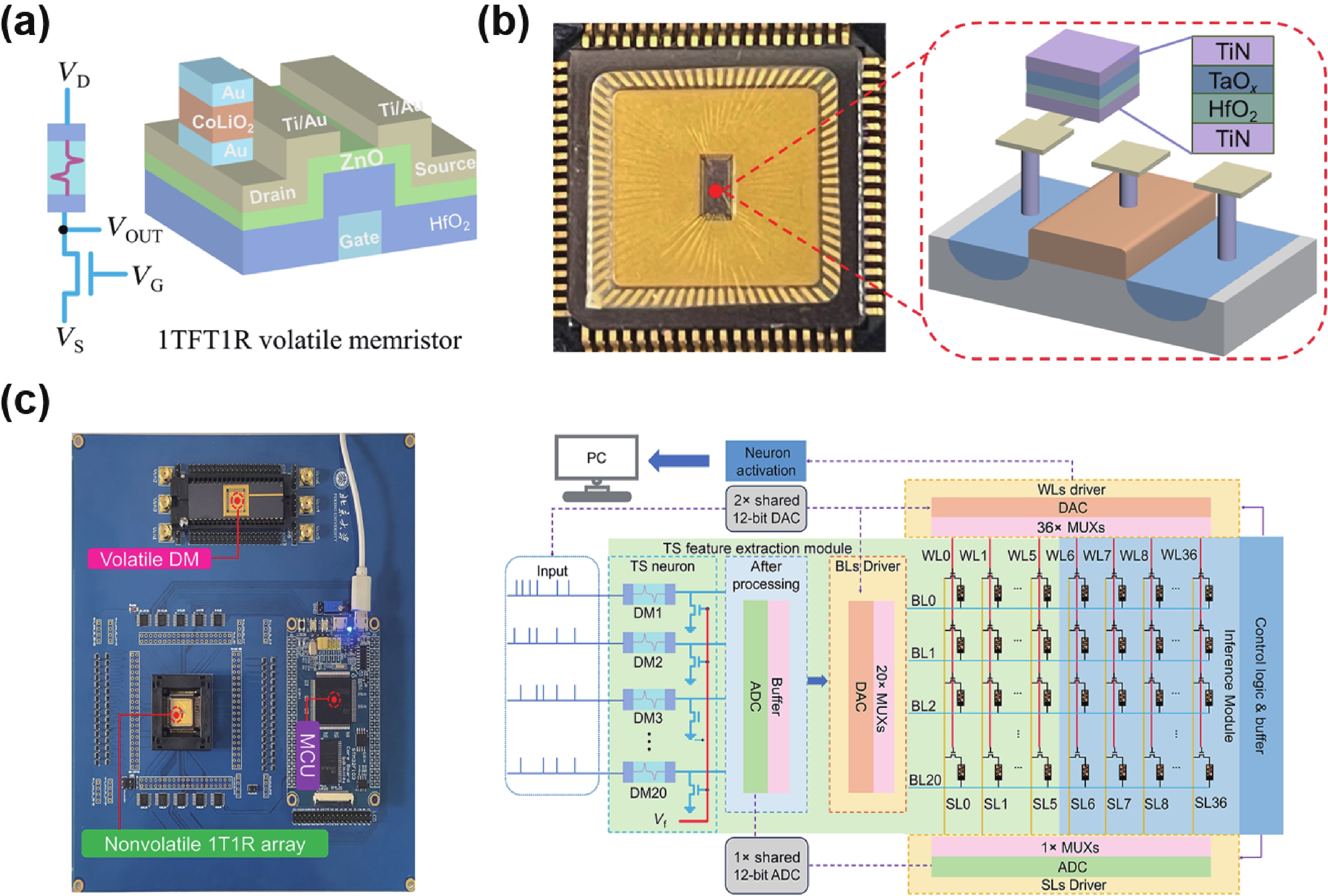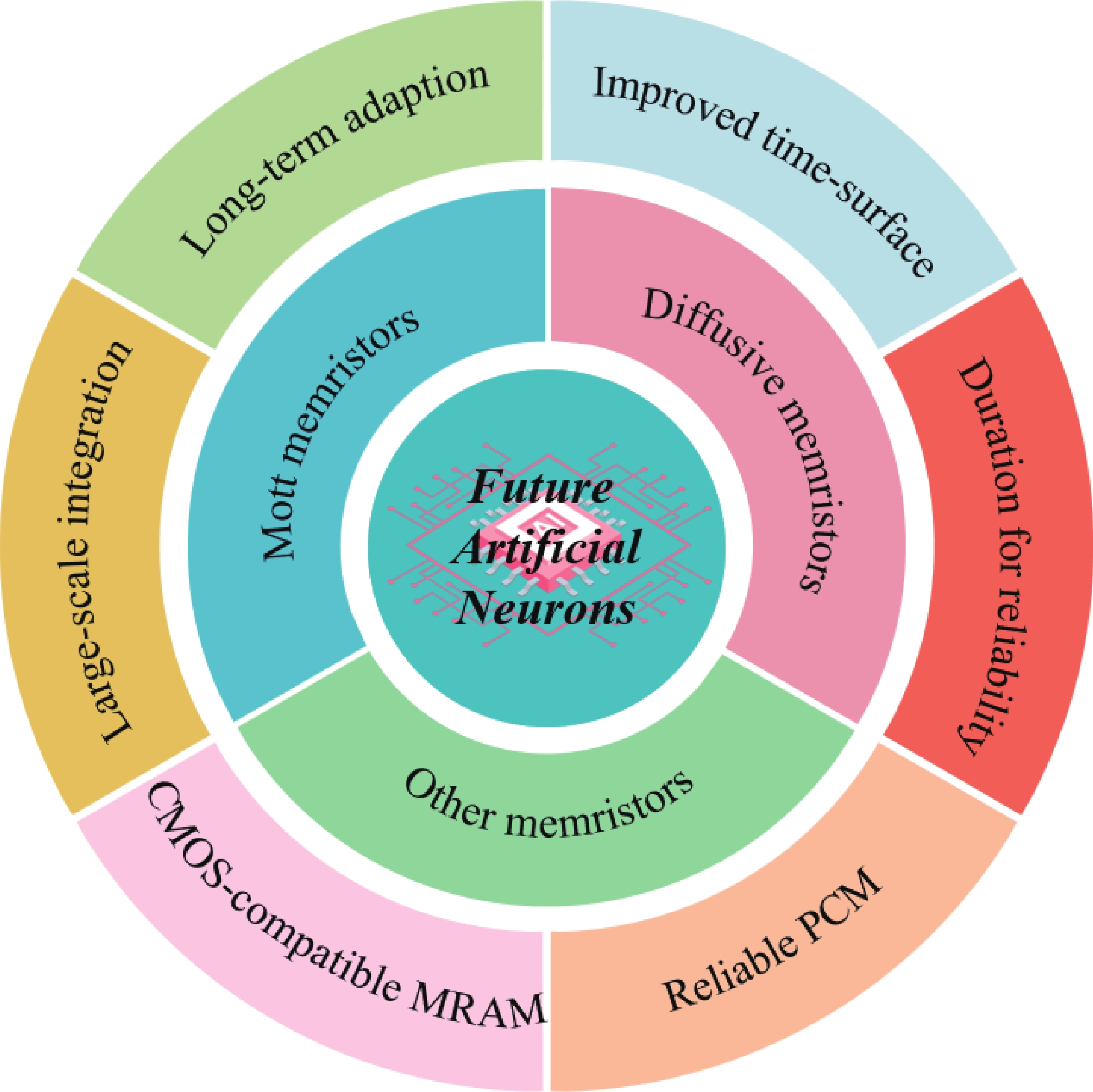| Citation: |
Yanning Chen, Guobin Zhang, Fang Liu, Bo Wu, Yongfeng Deng, Dawei Gao, Yishu Zhang. Revolutionizing neuromorphic computing with memristor-based artificial neurons[J]. Journal of Semiconductors, 2025, 46(6): 061301. doi: 10.1088/1674-4926/24110006
****
Y N Chen, G B Zhang, F Liu, B Wu, Y F Deng, D W Gao, and Y S Zhang, Revolutionizing neuromorphic computing with memristor-based artificial neurons[J]. J. Semicond., 2025, 46(6), 061301 doi: 10.1088/1674-4926/24110006
|
Revolutionizing neuromorphic computing with memristor-based artificial neurons
DOI: 10.1088/1674-4926/24110006
CSTR: 32376.14.1674-4926.24110006
More Information-
Abstract
As traditional von Neumann architectures face limitations in handling the demands of big data and complex computational tasks, neuromorphic computing has emerged as a promising alternative, inspired by the human brain's neural networks. Volatile memristors, particularly Mott and diffusive memristors, have garnered significant attention for their ability to emulate neuronal dynamics, such as spiking and firing patterns, enabling the development of reconfigurable and adaptive computing systems. Recent advancements include the implementation of leaky integrate-and-fire neurons, Hodgkin−Huxley neurons, optoelectronic neurons, and time-surface neurons, all utilizing volatile memristors to achieve efficient, low-power, and highly integrated neuromorphic systems. This paper reviews the latest progress in volatile memristor-based artificial neurons, highlighting their potential for energy-efficient computing and integration with artificial synapses. We conclude by addressing challenges such as improving memristor reliability and exploring new architectures to advance memristor-based neuromorphic computing. -
References
[1] Yang Z Y, Wang T Y, Lin Y H, et al. A vision chip with complementary pathways for open-world sensing. Nature, 2024, 629(8014), 1027 doi: 10.1038/s41586-024-07358-4[2] Wang X J, Li J M, Ning Z L, et al. Wireless powered mobile edge computing networks: A survey. ACM Comput Surv, 2023, 55(13s), 1 doi: 10.1145/3579992[3] Zhou Y, Pan C H, Yeoh P L, et al. Secure communications for UAV-enabled mobile edge computing systems. IEEE Trans Commun, 2020, 68(1), 376 doi: 10.1109/TCOMM.2019.2947921[4] Zhong Y N, Tang J S, Li X Y, et al. A memristor-based analogue reservoir computing system for real-time and power-efficient signal processing. Nat Electron, 2022, 5, 672 doi: 10.1038/s41928-022-00838-3[5] Wang Z R, Joshi S, Savel’ev S E, et al. Memristors with diffusive dynamics as synaptic emulators for neuromorphic computing. Nat Mater, 2017, 16(1), 101 doi: 10.1038/nmat4756[6] Zhang Z H, Wang S Y, Liu C S, et al. All-in-one two-dimensional retinomorphic hardware device for motion detection and recognition. Nat Nanotechnol, 2022, 17(1), 27 doi: 10.1038/s41565-021-01003-1[7] Marković D, Mizrahi A, Querlioz D, et al. Physics for neuromorphic computing. Nat Rev Phys, 2020, 2, 499 doi: 10.1038/s42254-020-0208-2[8] Chen P, Zhang X M, Wu Z H, et al. High-yield and uniform NbOx-based threshold switching devices for neuron applications. IEEE Trans Electron Devices, 2022, 69(5), 2391 doi: 10.1109/TED.2022.3161614[9] Sun L F, Wang Z R, Jiang J B, et al. In-sensor reservoir computing for language learning via two-dimensional memristors. Sci Adv, 2021, 7(20), eabg1455 doi: 10.1126/sciadv.abg1455[10] Qin F, Zhang Y X, Park H, et al. Factors determining the resistive switching behavior of transparent InGaZnO-based memristors. Physica Rapid Research Ltrs, 2022, 16(7), 2200075 doi: 10.1002/pssr.202200075[11] Qin F, Zhang Y X, Guo Z Q, et al. High on/off ratio SiO2-based memristors for neuromorphic computing: Understanding the switching mechanisms through theoretical and electrochemical aspects. Mater Adv, 2024, 5(10), 4209 doi: 10.1039/D3MA01142A[12] Wang Z J, Song Y X, Zhang G B, et al. Advances of embedded resistive random access memory in industrial manufacturing and its potential applications. Int J Extrem Manuf, 2024, 6(3), 032006 doi: 10.1088/2631-7990/ad2fea[13] Wuttig M, Yamada N. Phase-change materials for rewriteable data storage. Nature Mater, 2007, 6(11), 824 doi: 10.1038/nmat2009[14] Burr G W, Breitwisch M J, Franceschini M, et al. Phase change memory technology. Journal Vacuum Science & Technology B, Nanotechnology And Microelectronics: Materials, Processing, Measurement, And Phenomena, 2010, 28(2), 223 doi: 10.1116/1.3301579[15] Lee Y T, Kwon H, Kim J S, et al. Nonvolatile ferroelectric memory circuit using black phosphorus nanosheet-based field-effect transistors with P(VDF-TrFE) polymer. ACS Nano, 2015, 9(10), 10394 doi: 10.1021/acsnano.5b04592[16] Lipatov A, Sharma P, Gruverman A, et al. Optoelectrical molybdenum disulfide (MoS2): Ferroelectric memories. ACS Nano, 2015, 9(8), 8089 doi: 10.1021/acsnano.5b02078[17] Wang M X, Cai W L, Zhu D Q, et al. Field-free switching of a perpendicular magnetic tunnel junction through the interplay of spin–orbit and spin-transfer torques. Nat Electron, 2018, 1, 582 doi: 10.1038/s41928-018-0160-7[18] Engel B N, Akerman J, Butcher B, et al. A 4-Mb toggle MRAM based on a novel bit and switching method. IEEE Trans Magn, 2005, 41(1), 132 doi: 10.1109/TMAG.2004.840847[19] Pi S, Li C, Jiang H, et al. Memristor crossbar arrays with 6-nm half-pitch and 2-nm critical dimension. Nat Nanotechnol, 2019, 14(1), 35 doi: 10.1038/s41565-018-0302-0[20] Li J C, Ren S G, Li Y, et al. Sparse matrix multiplication in a record-low power self-rectifying memristor array for scientific computing. Sci Adv, 2023, 9(25), eadf7474 doi: 10.1126/sciadv.adf7474[21] Zhang W B, Yao P, Gao B, et al. Edge learning using a fully integrated neuro-inspired memristor chip. Science, 2023, 381(6663), 1205 doi: 10.1126/science.ade3483[22] Lanza M, Sebastian A, Lu W D, et al. Memristive technologies for data storage, computation, encryption, and radio-frequency communication. Science, 2022, 376(6597), eabj9979 doi: 10.1126/science.abj9979[23] Guo T, Pan K Q, Jiao Y X, et al. Versatile memristor for memory and neuromorphic computing. Nanoscale Horiz, 2022, 7(3), 299 doi: 10.1039/D1NH00481F[24] Zhou G D, Wang Z R, Sun B, et al. Volatile and nonvolatile memristive devices for neuromorphic computing. Adv Elect Materials, 2022, 8(7), 2101127 doi: 10.1002/aelm.202101127[25] Pickett M D, Medeiros-Ribeiro G, Williams R S. A scalable neuristor built with Mott memristors. Nature Mater, 2013, 12(2), 114 doi: 10.1038/nmat3510[26] Milozzi A, Ricci S, Ielmini D. Memristive tonotopic mapping with volatile resistive switching memory devices. Nat Commun, 2024, 15(1), 2812 doi: 10.1038/s41467-024-47228-1[27] Lu Y F, Li Y, Li H Y, et al. Low-power artificial neurons based on Ag/TiN/HfAlOx/Pt threshold switching memristor for neuromorphic computing. IEEE Electron Device Lett, 2020, 41(8), 1245 doi: 10.1109/LED.2020.3006581[28] Park S O, Jeong H, Park J, et al. Experimental demonstration of highly reliable dynamic memristor for artificial neuron and neuromorphic computing. Nat Commun, 2022, 13(1), 2888 doi: 10.1038/s41467-022-30539-6[29] Yi W, Tsang K K, Lam S K, et al. Biological plausibility and stochasticity in scalable VO2 active memristor neurons. Nat Commun, 2018, 9(1), 4661 doi: 10.1038/s41467-018-07052-w[30] Teeter C, Iyer R, Menon V, et al. Generalized leaky integrate-and-fire models classify multiple neuron types. Nat Commun, 2018, 9, 709 doi: 10.1038/s41467-017-02717-4[31] Wang Z R, Joshi S, Savel’ev S, et al. Fully memristive neural networks for pattern classification with unsupervised learning. Nat Electron, 2018, 1, 137 doi: 10.1038/s41928-018-0023-2[32] Stoliar P, Tranchant J, Corraze B, et al. A leaky-integrate-and-fire neuron analog realized with a Mott insulator. Adv Funct Materials, 2017, 27(11), 1604740 doi: 10.1002/adfm.201604740[33] Luo Q, Zhang X M, Yu J, et al. Memory switching and threshold switching in a 3D nanoscaled NbOX system. IEEE Electron Device Lett, 2019, 40(5), 718 doi: 10.1109/LED.2019.2904279[34] Dagotto E. Complexity in strongly correlated electronic systems. Science, 2005, 309(5732), 257 doi: 10.1126/science.1107559[35] Janod E, Tranchant J, Corraze B, et al. Resistive switching in Mott insulators and correlated systems. Adv Funct Materials, 2015, 25(40), 6287 doi: 10.1002/adfm.201500823[36] Heidrich-Meisner F, González I, Al-Hassanieh K A, et al. Nonequilibrium electronic transport in a one-dimensional Mott insulator. Phys Rev B, 2010, 82(20), 205110 doi: 10.1103/PhysRevB.82.205110[37] Newns D M, Misewich J A, Tsuei C C, et al. Mott transition field effect transistor. Appl Phys Lett, 1998, 73(6), 780 doi: 10.1063/1.121999[38] Rocco R, del Valle J, Navarro H, et al. Exponential escape rate of filamentary incubation in Mott spiking neurons. Phys Rev Applied, 2022, 17(2), 024028 doi: 10.1103/PhysRevApplied.17.024028[39] Zhang X M, Zhuo Y, Luo Q, et al. An artificial spiking afferent nerve based on Mott memristors for neurorobotics. Nat Commun, 2020, 11(1), 51 doi: 10.1038/s41467-019-13827-6[40] Yuan R, Tiw P J, Cai L, et al. A neuromorphic physiological signal processing system based on VO2 memristor for next-generation human-machine interface. Nat Commun, 2023, 14(1), 3695 doi: 10.1038/s41467-023-39430-4[41] Li X Y, Zhong Y N, Chen H, et al. A memristors-based dendritic neuron for high-efficiency spatial-temporal information processing. Adv Mater, 2023, 35(37), 2203684 doi: 10.1002/adma.202203684[42] Kim G, In J H, Lee Y, et al. Mott neurons with dual thermal dynamics for spatiotemporal computing. Nat Mater, 2024, 23(9), 1237 doi: 10.1038/s41563-024-01913-0[43] Park W, Kim G, In J H, et al. High amplitude spike generator in Au nanodot-incorporated NbOx Mott memristor. Nano Lett, 2023, 23(11), 5399 doi: 10.1021/acs.nanolett.2c04599[44] Oh S, Shi Y H, Del Valle J, et al. Energy-efficient Mott activation neuron for full-hardware implementation of neural networks. Nat Nanotechnol, 2021, 16(6), 680 doi: 10.1038/s41565-021-00874-8[45] Jeon Y R, Akinwande D, Choi C. Volatile threshold switching and synaptic properties controlled by Ag diffusion using Schottky defects. Nanoscale Horiz, 2024, 9(5), 853 doi: 10.1039/D3NH00571B[46] Woo K S, Park H, Ghenzi N, et al. Memristors with tunable volatility for reconfigurable neuromorphic computing. ACS Nano, 2024, 18(26), 17007 doi: 10.1021/acsnano.4c03238[47] Kim D, Shin J, Kim S. Implementation of reservoir computing using volatile WO x-based memristor. Appl Surf Sci, 2022, 599, 153876 doi: 10.1016/j.apsusc.2022.153876[48] Zhang X M, Wang W, Liu Q, et al. An artificial neuron based on a threshold switching memristor. IEEE Electron Device Lett, 2018, 39(2), 308 doi: 10.1109/LED.2017.2782752[49] Lin J M, Ye W X, Zhang X H, et al. A memristor-based leaky integrate-and-fire artificial neuron with tunable performance. IEEE Electron Device Lett, 2022, 43(8), 1231 doi: 10.1109/LED.2022.3184671[50] Wang Z R, Rao M Y, Han J W, et al. Capacitive neural network with neuro-transistors. Nat Commun, 2018, 9, 3208 doi: 10.1038/s41467-018-05677-5[51] Valov I, Linn E, Tappertzhofen S, et al. Nanobatteries in redox-based resistive switches require extension of memristor theory. Nat Commun, 2013, 4, 1771 doi: 10.1038/ncomms2784[52] Yang J Q, Wang R P, Wang Z P, et al. Leaky integrate-and-fire neurons based on perovskite memristor for spiking neural networks. Nano Energy, 2020, 74, 104828 doi: 10.1016/j.nanoen.2020.104828[53] Ma J, Tang J. A review for dynamics in neuron and neuronal network. Nonlinear Dyn, 2017, 89(3), 1569 doi: 10.1007/s11071-017-3565-3[54] Chua L, Sbitnev V, Kim H. Hodgkin–Huxley axon is made of memristors. Int J Bifurcation Chaos, 2012, 22(3), 1230011 doi: 10.1142/S021812741230011X[55] Qiu E B, Salev P, Torres F, et al. Stochastic transition in synchronized spiking nanooscillators. Proc Natl Acad Sci USA, 2023, 120(38), e2303765120 doi: 10.1073/pnas.2303765120[56] Bidoul N, Roisin N, Flandre D. Tuning the intrinsic stochasticity of resistive switching in VO2 microresistors. Nano Lett, 2024, 24(21), 6201 doi: 10.1021/acs.nanolett.4c00184[57] Pecevski D, Buesing L, Maass W. Probabilistic inference in general graphical models through sampling in stochastic networks of spiking neurons. PLoS Comput Biol, 2011, 7(12), e1002294 doi: 10.1371/journal.pcbi.1002294[58] Tsai H C, Zhang F, Adamantidis A, et al. Phasic firing in dopaminergic neurons is sufficient for behavioral conditioning. Science, 2009, 324(5930), 1080 doi: 10.1126/science.1168878[59] Yuan R, Duan Q X, Tiw P J, et al. A calibratable sensory neuron based on epitaxial VO2 for spike-based neuromorphic multisensory system. Nat Commun, 2022, 13(1), 3973 doi: 10.1038/s41467-022-31747-w[60] Yang Y, Zhang X M, Chen P, et al. Fully integrated memristive Hodgkin-Huxley neurons with homeostatic plasticity. IEEE Electron Device Lett, 2024, 45(11), 2225 doi: 10.1109/LED.2024.3456816[61] Li F F, Li D W, Wang C Q, et al. An artificial visual neuron with multiplexed rate and time-to-first-spike coding. Nat Commun, 2024, 15(1), 3689 doi: 10.1038/s41467-024-48103-9[62] Ren H H, Li F F, Wang M, et al. An ion-mediated spiking chemical neuron based on Mott memristor. Adv Mater, 2024, 36(33), 2403678 doi: 10.1002/adma.202403678[63] Waldrop M M. More than moore. Nature, 2016, 530, 144[64] Manipatruni S, Nikonov D E, Young I A. Beyond CMOS computing with spin and polarization. Nature Phys, 2018, 14(4), 338 doi: 10.1038/s41567-018-0101-4[65] Hutchby J A, Bourianoff G I, Zhirnov V V, et al. Extending the road beyond CMOS. IEEE Circuits Devices Mag, 2002, 18(2), 28 doi: 10.1109/101.994856[66] Seabaugh A C, Zhang Q. Low-voltage tunnel transistors for beyond CMOS logic. Proc IEEE, 2010, 98(12), 2095 doi: 10.1109/JPROC.2010.2070470[67] Tan H W, van Dijken S. Dynamic machine vision with retinomorphic photomemristor-reservoir computing. Nat Commun, 2023, 14(1), 2169 doi: 10.1038/s41467-023-37886-y[68] Tapiador-Morales R, Maro J M, Jimenez-Fernandez A, et al. Event-based gesture recognition through a hierarchy of time-surfaces for FPGA. Sensors, 2020, 20(12), 3404 doi: 10.3390/s20123404[69] Wu X L, Dang B J, Zhang T, et al. Spatiotemporal audio feature extraction with dynamic memristor-based time-surface neurons. Sci Adv, 2024, 10(14), eadl2767 doi: 10.1126/sciadv.adl2767[70] Qin F, Zhang Y X, Song H W, et al. Enhancing memristor fundamentals through instrumental characterization and understanding reliability issues. Mater Adv, 2023, 4(8), 1850 doi: 10.1039/D3MA00069A[71] Zhao M R, Wu H Q, Gao B, et al. Characterizing endurance degradation of incremental switching in analog RRAM for neuromorphic systems. 2018 IEEE International Electron Devices Meeting (IEDM), 2018, 20.2.1 doi: 10.1109/IEDM.2018.8614664[72] Li Y S, Ang K W. Hardware implementation of neuromorphic computing using large-scale memristor crossbar arrays. Adv Intell Syst, 2021, 3(1), 2000137 doi: 10.1002/aisy.202000137[73] Yao G L, Lei T, Zhong J D. A review of convolutional-neural-network-based action recognition. Pattern Recognit Lett, 2019, 118, 14 doi: 10.1016/j.patrec.2018.05.018[74] Rabault J, Kuchta M, Jensen A, et al. Artificial neural networks trained through deep reinforcement learning discover control strategies for active flow control. J Fluid Mech, 2019, 865, 281 doi: 10.1017/jfm.2019.62[75] Li H, Ota K, Dong M X. Learning IoT in edge: Deep learning for the Internet of Things with edge computing. IEEE Netw, 2018, 32(1), 96 doi: 10.1109/MNET.2018.1700202[76] Liu Y, Yu H M, Xie S L, et al. Deep reinforcement learning for offloading and resource allocation in vehicle edge computing and networks. IEEE Trans Veh Technol, 2019, 68(11), 11158 doi: 10.1109/TVT.2019.2935450[77] Al-Bustami H, Koplovitz G, Primc D, et al. Single nanoparticle magnetic spin memristor. Small, 2018, 14(30), 1801249 doi: 10.1002/smll.201801249[78] Yuasa S, Nagahama T, Fukushima A, et al. Giant room-temperature magnetoresistance in single-crystal Fe/MgO/Fe magnetic tunnel junctions. Nat Mater, 2004, 3, 868 doi: 10.1038/nmat1257[79] Zhang D M, Zeng L, Cao K H, et al. All spin artificial neural networks based on compound spintronic synapse and neuron. IEEE Trans Biomed Circuits Syst, 2016, 10(4), 828 doi: 10.1109/TBCAS.2016.2533798[80] Cai J L, Fang B, Zhang L K, et al. Voltage-controlled spintronic stochastic neuron based on a magnetic tunnel junction. Phys Rev Applied, 2019, 11(3), 034015 doi: 10.1103/PhysRevApplied.11.034015[81] Zhang D M, Zeng L, Zhang Y G, et al. Stochastic spintronic device based synapses and spiking neurons for neuromorphic computation. 2016 IEEE/ACM International Symposium on Nanoscale Architectures (NANOARCH), 2016, 173 doi: 10.1145/2950067.2950105[82] Tuma T, Pantazi A, Le Gallo M, et al. Stochastic phase-change neurons. Nat Nanotechnol, 2016, 11(8), 693 doi: 10.1038/nnano.2016.70[83] Liu K Q, Zhang T, Dang B J, et al. An optoelectronic synapse based on α-In2Se3 with controllable temporal dynamics for multimode and multiscale reservoir computing. Nat Electron, 2022, 5, 761 doi: 10.1038/s41928-022-00847-2 -
Proportional views





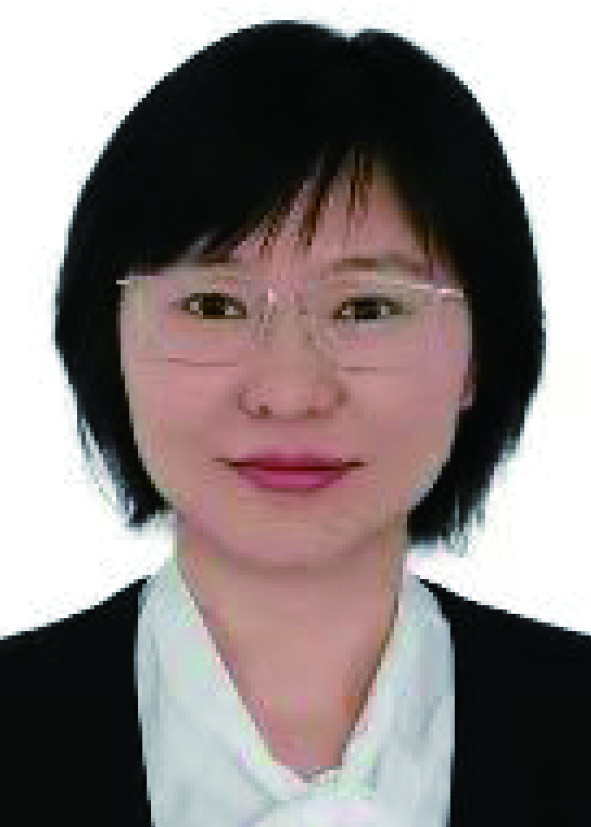 Yanning Chen received the B.S. degree in computer scienee from Capital Normal University, Beijing, China, in 2002, and the M.S. degree in electronic and communication engineering from Beijing University of Posts and Telecommunications, Beijing, in 2018. She is currently pursuing the Ph.D. degree with the IC College, Zhejiang University. She is a Senior Engineer, the Director of the R & D Center. She has long been engaged in industrialchip design and generie technology research. She led the team to study the application environment of power industry chips, formulate relevant technical standards, and establish the quality assurance system of industrial chips.
Yanning Chen received the B.S. degree in computer scienee from Capital Normal University, Beijing, China, in 2002, and the M.S. degree in electronic and communication engineering from Beijing University of Posts and Telecommunications, Beijing, in 2018. She is currently pursuing the Ph.D. degree with the IC College, Zhejiang University. She is a Senior Engineer, the Director of the R & D Center. She has long been engaged in industrialchip design and generie technology research. She led the team to study the application environment of power industry chips, formulate relevant technical standards, and establish the quality assurance system of industrial chips.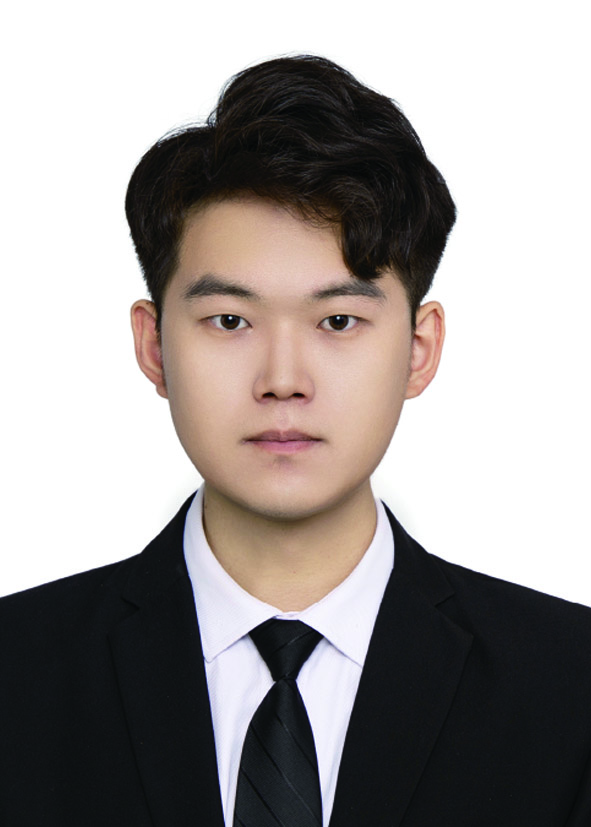 Guobin Zhang received his bachelor's degree from Harbin Institute of Technology in 2019. Now he is a master student in the College of Integrated Circuits at Zhejiang University. His research focuses on RRAM-based in-memory computing architecture and energy-efficient neuromorphic computing.
Guobin Zhang received his bachelor's degree from Harbin Institute of Technology in 2019. Now he is a master student in the College of Integrated Circuits at Zhejiang University. His research focuses on RRAM-based in-memory computing architecture and energy-efficient neuromorphic computing. Dawei Gao born in March 1969, is a Researcher and Doctoral Supervisor. He graduated from Kyushu University, Japan, in 1998 with a degree in Electronic Engineering. Dr. Gao Dawei's research interests are primarily focused on integrated circuit manufacturing, logic/analog circuit processes, power devices, and power management. As the Director of the Institute of Advanced Integrated Circuit Manufacturing Technology of Zhejiang University, he is committed to exploring cutting-edge technologies in these fields and promoting the development of the Zhejiang Provincial Integrated Circuit Innovation Platform.
Dawei Gao born in March 1969, is a Researcher and Doctoral Supervisor. He graduated from Kyushu University, Japan, in 1998 with a degree in Electronic Engineering. Dr. Gao Dawei's research interests are primarily focused on integrated circuit manufacturing, logic/analog circuit processes, power devices, and power management. As the Director of the Institute of Advanced Integrated Circuit Manufacturing Technology of Zhejiang University, he is committed to exploring cutting-edge technologies in these fields and promoting the development of the Zhejiang Provincial Integrated Circuit Innovation Platform.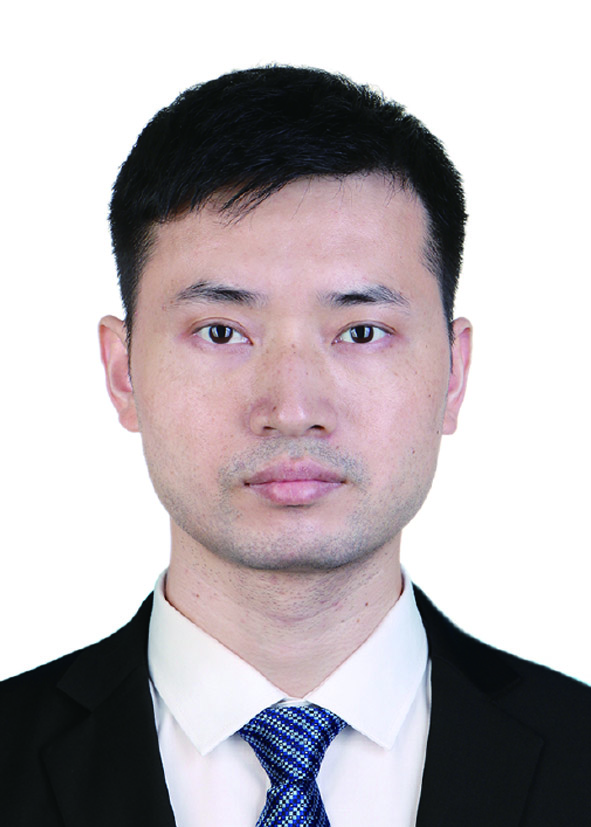 Yishu Zhang is a researcher and Ph.D. supervisor at Zhejiang University, specializing in memristors, in-memory computing, neuromorphic computing, and IC process development. He received his PhD degree from Singapore University of Technology and Design in 2019. With over 30 publications and multiple patents, he leads projects funded by national and provincial grants and serves as a young editorial board member for several journals.
Yishu Zhang is a researcher and Ph.D. supervisor at Zhejiang University, specializing in memristors, in-memory computing, neuromorphic computing, and IC process development. He received his PhD degree from Singapore University of Technology and Design in 2019. With over 30 publications and multiple patents, he leads projects funded by national and provincial grants and serves as a young editorial board member for several journals.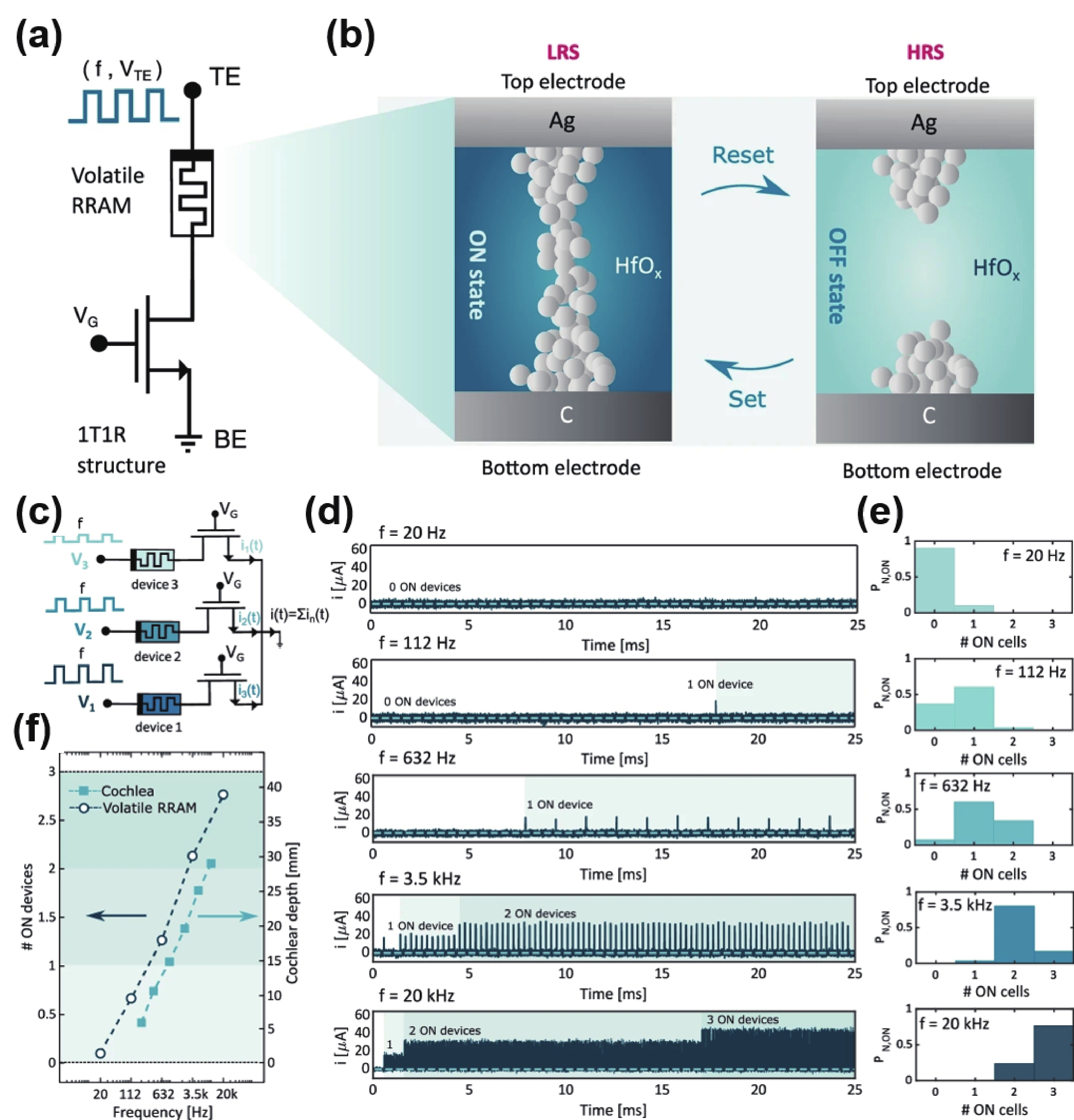
 DownLoad:
DownLoad:


